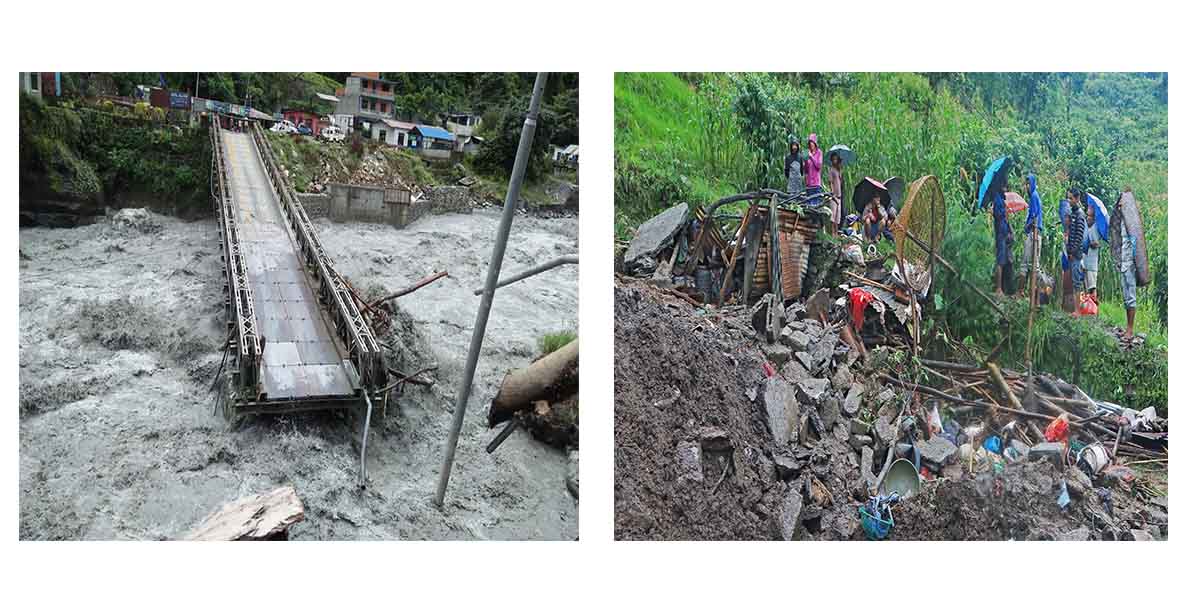
OR
Five-step solution to disaster risk management
Published On: July 26, 2020 03:00 PM NPT By: Krishna Devkota and Ghanshyam Khanal


Krishna Devkota and Ghanshyam Khanal
Krishna Devkota is a research fellow, at Global Institute for Interdisciplinary Studies, Kathmandu. Ghanshyam Khanal is lecturer of Economics at Morgan International College, Kathmandunews@myrepublica.com
More from Author
Following the steps of preventing and mitigating risk, addressing residual risk, preparing, responding, and recovering can play a vital role to reduce the risk of disaster and build a resilient community.
"As many as 112 people died while 49 are missing due to flood and landslide in various parts of the country in last three months," reported National Disaster Risk Reduction and Management Authority on July 18.
We can find myriad of frequent disasters and associated loss of life and property in Nepal. The earthquakes of 2015 toppled buildings, triggered landslides and avalanches in the Himalayan mountains, besides killing nearly 9,000 people and injuring more than 22,000 people. In 2017 flood, 134 people lost lives in 18 most affected districts. Last year, a severe rainstorm in southern Nepal killed 28 people.
Earlier in 2017, Global Facility for Disaster Reduction and Recovery listed Kathmandu Valley as the world’s most at-risk urban area to seismic activity. Data shows that between 1990– 2019, seismic events have caused over USD eight billion in damages and affected nearly six million people in Nepal. ILO (2019) warns that these recurrent, large-scale disasters have further increased the country’s reliance on agriculture by obstructing critical infrastructure, such as transport and electricity production, thus delaying the development of other industries.
Along with earthquakes, landslides, flood and lightening have caused huge damage in Nepal. Most of the monsoonal precipitation during June and September triggers regular flooding in the low-lying Tarai and landslides in the hills. In 2019, National Planning Commission (NPC) observed that 80 percent of the Tarai region and some surrounding districts suffered inundation triggered by monsoonal rains, causing US$ 584.7 million in damages. Historically, flooding has caused the most significant economic damages in the country. Droughts have had similar effects, as unusual patterns of rain and droughts have caused yearly crop losses ranging from five to 35 percent in 2007-2019. The total value of crops lost due to extreme weather amounts to around US$ 1.5 billion.
The World Bank (2019) reported that the social implications of hazards affecting the main employment sectors are severe. Loss of livelihoods results in increased poverty and the loss of agricultural crops rapidly turns into food insecurity. For example, the losses of crops to droughts in 2006 and 2009 led to food deficits of 400,000 tons, which increased the food prices by 117-300 percent in various parts of the country, according to the 2018 UNDP report. According to ILO, in 2015 the Gorkha earthquake, its aftershocks and accompanying landslides drove an estimated 2.5- 3.5 percent of Nepali population into poverty by destroying crops, livestock, agricultural tools and buildings.
These natural hazards can greatly damage people's houses, businesses and resources and can even push them into a vicious cycle of poverty. But it does not have to be like this and we cannot afford this loss of life and property all the time. As the frequency and intensity of natural hazards continues to increase, there also are ways to increase resilience to these events with the help of insurance and other risk transfer instruments to better protect people against possible natural hazards.
Five-step plan
The following five steps can play a vital role to reduce the risk of disaster and build a resilient community: preventing and mitigating risk, addressing residual risk, preparing, responding, and recovering. These steps are all part of a disaster risk management approach that integrates risk transfer solutions.
For the prevention and mitigation of risks, the first thing to be done to help prevent serious damage is risk analysis/assessment which identifies the hazards in a specific area and analyzes how exposed people, businesses, agricultural fields and infrastructure are. This analysis will reveal what can be done to prevent damage and feed into the risk transfer instruments and early warning systems in the next phases.
In this area of prevention and mitigation, the community can work in areas such as bamboo plantation, build a wall to protect farmland and infrastructure from heavy rain or clean drainage systems to prevent flooding together with local government utilizing their indigenous knowledge, local resources, and policies. The local government can develop a scientific land-use policy and planning considering disaster risk so that it can be implemented or enforced for sustainable solutions regarding flood, drought, lightning, landslide, epidemic and earthquake hazards.
Second, even if preventive and mitigative measures are in place, some residual risk remains. This is where ex-ante financing—financing before a hazard strikes—can help. A micro-insurance policy can help individuals to bear some damages. Weather index insurance, which pays out when there has been too much or too little rain throughout the year, could be a good option for the farmers. By using funds at federal, provincial, district and local level can also protect their citizens with pre-disaster financing using contingent debt facilities which ensure that funding will be available immediately after a hazard hits and by taking out their own insurance. This money can then be used to provide emergency relief to the affected people or support reconstruction. Implementing different prevention measures will greatly help in reducing the cost of insurance and financial instruments because they significantly reduce the overall risk exposure.
After the individuals and community protect themselves with ex-ante financing, they need to prepare themselves for natural hazards. They can do this by stockpiling food and water in case of an emergency and making sure that they have a safe place to take shelter. The government can also train individuals in rescue and emergency services, establish early warning systems, and come up with a contingency plan to ensure that everyone knows what to do. Adaptation investments—investments made to help countries adapt to climate change, microcredit and increasing savings—could also be good options for the government to better prepare.
When a natural hazard hits at some places, it is essential for the community and the government to respond quickly to avoid further loss of human life or material damage. They can do this by helping with the search and rescue effort providing temporary shelter and food and quickly repairing the most needed infrastructure. The extravagant government expenditure should be minimized, and it should be distributed to the victims immediately. The ex-ante financing will play a big role in making this quick response possible. It may also be necessary to acquire some ex-post financing by increasing taxes, reallocating national budgets, or taking out credit. Without this financing, it can be very difficult for people and the government to get back on their feet.
After responding to the first impacts of disaster, people can start the recovery process. The good news is that with the right assistance from the government, community organizations and possible payouts from the insurance, people can start to build back better—more resilient than before. This can be done by examining the affected areas and repairing things in a smarter way so as to prevent future damages. All these steps are linked with each other and are most effective when countries and their governments, communities and individuals work together. When everyone knows what should be done to prepare for a natural hazard, the consequences will be much less severe.
Traditionally, disasters were addressed mainly from a humanitarian perspective and priority was given to immediate rescue and relief works. Now, it is highly necessary to take preparedness actions and build a culture of resilience so that more lives and properties may be saved in the time of disaster. Improving and strengthening capacity in prevention, mitigation, preparedness, response, and recovery in collaboration with local, provincial, federal governments and development partners is the better way to reduce disaster vulnerability.
Time to think about this five-step solution.
Krishna Devkota is a research fellow, at Global Institute for Interdisciplinary Studies, Kathmandu. Ghanshyam Khanal is lecturer of Economics at Morgan International College, Kathmandu
You May Like This

Is COVID-19 killing democracy?
BRUSSELS – The economic consequences of the COVID-19 crisis occupy almost everyone’s thoughts and conversations. And for good reason: the... Read More...

Lockdown Lessons
Divya Mittal, a clinical nutritionist at Tesla Diagnostics Clinic, has been exercising and meditating ever since the lockdown started. And... Read More...

Sajilo Marmat Sewa: One Stop Maintenance Solution
KATHMANDU: ‘Sajilo Marmat Sewa’ (SMS) is Nepal’s first one stop maintenance solution for business organizations and households in Kathmandu, Lalitpur... Read More...




Just In
- Govt receives 1,658 proposals for startup loans; Minimum of 50 points required for eligibility
- Unified Socialist leader Sodari appointed Sudurpaschim CM
- One Nepali dies in UAE flood
- Madhesh Province CM Yadav expands cabinet
- 12-hour OPD service at Damauli Hospital from Thursday
- Lawmaker Dr Sharma provides Rs 2 million to children's hospital
- BFIs' lending to private sector increases by only 4.3 percent to Rs 5.087 trillion in first eight months of current FY
- NEPSE nosedives 19.56 points; daily turnover falls to Rs 2.09 billion















Leave A Comment